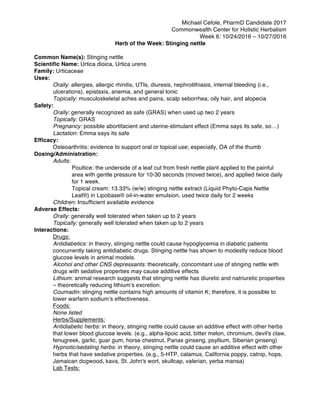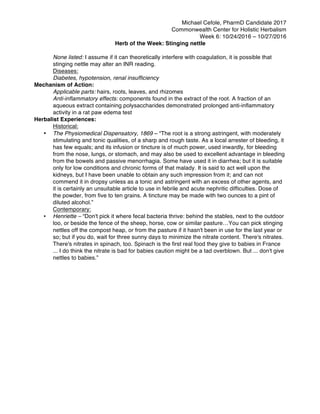Stinging Nettle
- 1. Michael Cefole, PharmD Candidate 2017 Commonwealth Center for Holistic Herbalism Week 6: 10/24/2016 â 10/27/2016 Herb of the Week: Stinging nettle Common Name(s): Stinging nettle Scientific Name: Urtica dioica, Urtica urens Family: Urticaceae Uses: Orally: allergies, allergic rhinitis, UTIs, diuresis, nephrolithiasis, internal bleeding (i.e., ulcerations), epistaxis, anemia, and general tonic Topically: musculoskeletal aches and pains, scalp seborrhea, oily hair, and alopecia Safety: Orally: generally recognized as safe (GRAS) when used up two 2 years Topically: GRAS Pregnancy: possible abortifacient and uterine-stimulant effect (Emma says its safe, soâĶ) Lactation: Emma says its safe Efficacy: Osteoarthritis: evidence to support oral or topical use; especially, OA of the thumb Dosing/Administration: Adults: Poultice: the underside of a leaf cut from fresh nettle plant applied to the painful area with gentle pressure for 10-30 seconds (moved twice), and applied twice daily for 1 week. Topical cream: 13.33% (w/w) stinging nettle extract (Liquid Phyto-Caps Nettle LeafÂŪ) in LipobaseÂŪ oil-in-water emulsion, used twice daily for 2 weeks Children: Insufficient available evidence Adverse Effects: Orally: generally well tolerated when taken up to 2 years Topically: generally well tolerated when taken up to 2 years Interactions: Drugs: Antidiabetics: in theory, stinging nettle could cause hypoglycemia in diabetic patients concurrently taking antidiabetic drugs. Stinging nettle has shown to modestly reduce blood glucose levels in animal models. Alcohol and other CNS depressants: theoretically, concomitant use of stinging nettle with drugs with sedative properties may cause additive effects Lithium: animal research suggests that stinging nettle has diuretic and natriuretic properties â theoretically reducing lithiumâs excretion. Coumadin: stinging nettle contains high amounts of vitamin K; therefore, it is possible to lower warfarin sodiumâs effectiveness. Foods: None listed Herbs/Supplements: Antidiabetic herbs: in theory, stinging nettle could cause an additive effect with other herbs that lower blood glucose levels. (e.g., alpha-lipoic acid, bitter melon, chromium, devil's claw, fenugreek, garlic, guar gum, horse chestnut, Panax ginseng, psyllium, Siberian ginseng) Hypnotic/sedating herbs: in theory, stinging nettle could cause an additive effect with other herbs that have sedative properties. (e.g., 5-HTP, calamus, California poppy, catnip, hops, Jamaican dogwood, kava, St. John's wort, skullcap, valerian, yerba mansa) Lab Tests:
- 2. Michael Cefole, PharmD Candidate 2017 Commonwealth Center for Holistic Herbalism Week 6: 10/24/2016 â 10/27/2016 Herb of the Week: Stinging nettle None listed: I assume if it can theoretically interfere with coagulation, it is possible that stinging nettle may alter an INR reading. Diseases: Diabetes, hypotension, renal insufficiency Mechanism of Action: Applicable parts: hairs, roots, leaves, and rhizomes Anti-inflammatory effects: components found in the extract of the root. A fraction of an aqueous extract containing polysaccharides demonstrated prolonged anti-inflammatory activity in a rat paw edema test Herbalist Experiences: Historical: âĒ The Physiomedical Dispensatory, 1869 â âThe root is a strong astringent, with moderately stimulating and tonic qualities, of a sharp and rough taste. As a local arrester of bleeding, it has few equals; and its infusion or tincture is of much power, used inwardly, for bleeding from the nose, lungs, or stomach, and may also be used to excellent advantage in bleeding from the bowels and passive menorrhagia. Some have used it in diarrhea; but it is suitable only for low conditions and chronic forms of that malady. It is said to act well upon the kidneys, but I have been unable to obtain any such impression from it; and can not commend it in dropsy unless as a tonic and astringent with an excess of other agents, and it is certainly an unsuitable article to use in febrile and acute nephritic difficulties. Dose of the powder, from five to ten grains. A tincture may be made with two ounces to a pint of diluted alcohol.â Contemporary: âĒ Henriette â âDon't pick it where fecal bacteria thrive: behind the stables, next to the outdoor loo, or beside the fence of the sheep, horse, cow or similar pastureâĶYou can pick stinging nettles off the compost heap, or from the pasture if it hasn't been in use for the last year or so; but if you do, wait for three sunny days to minimize the nitrate content. There's nitrates. There's nitrates in spinach, too. Spinach is the first real food they give to babies in France ... I do think the nitrate is bad for babies caution might be a tad overblown. But ... don't give nettles to babies.â

